When we talk about MEME, what are we talking about?
Author: Zeke, YBB Capital Researcher
Introduction
Recently, with the approval of the BTC spot ETF, market enthusiasm has gradually reached its peak. Led by the inscriptions and the Solana community, MEME Coins have once again swept in, with various myths of making thousands or even tens of thousands of times in profits going viral on social media, and retail investors who missed the rally are continuously flooding into the market.
So, what is different about the recent MEME Coins compared to the past? In a market filled with "shitcoins," how can one select a MEME Coin with potential?
What is a MEME Coin?
The concept of "MEME" was first proposed by British evolutionary biologist Richard Dawkins in his 1976 book "The Selfish Gene." Dawkins used the term MEME to describe units of cultural information that spread from person to person, similar to how genes propagate in biology. His aim was to explain the process of cultural transmission. If the basic unit of biological evolution relies on the inheritance of genes, then the basic unit of cultural thought transmission is the MEME. Its forms are diverse, ranging from a sentence, a story, an allusion, to an image; anything that can carry a certain cultural idea can be called a MEME.
Although the term MEME was initially a serious academic concept, it was redefined in the internet age to encompass various forms of internet meme culture, akin to the term "梗" in Chinese internet culture.
The so-called MEME Coin is, as the name suggests, a cryptocurrency based on MEME culture, with Dogecoin often considered the first MEME Coin. Dogecoin was created in 2013 by Billy Markus and Jackson Palmer as a parody token, replicating Litecoin's code and featuring a Shiba Inu meme, mocking BTC (which they viewed as just air). However, the subsequent development was more ironic; Dogecoin not only did not become a worthless token but was also wildly embraced by Reddit, and a comment from billionaire Elon Musk stating, "Dogecoin might be my favorite cryptocurrency, it's cool," propelled it "To Da Moon." The market cap of Dogecoin began to skyrocket, turning a joke into a legendary billion-dollar asset in the crypto market.
The Hottest MEMEs of 2023
In the 21 years since Dogecoin shot to the moon, various parody tokens adorned with animal images have sprung up like mushrooms, all hoping to become the next Dogecoin. At that time, the community had a fun nickname for these tokens—"zoo coins." However, only a few outstanding ones, such as Shib and Floki, survived, while 99% of the "zoo coins" eventually turned to air in the subsequent bear market. It seems that selecting a MEME Coin that could become the next Dogecoin is akin to finding a needle in a haystack. So, how should one choose a MEME Coin that appears to have no fundamentals to analyze? In a new bull market ignited by inscriptions, how should we change our mindset? Let's first look back at the MEME Coins from 2023 that left a lasting impression during the bear market (selected from some tokens that I found memorable) and see what commonalities and innovations they share.
PEPE
Pepe the Frog (PEPE) was created by American cartoonist Matt Furie in 2005 for his comic "Boy's Club." Although this frog-headed character has remained evergreen in Western social networks, there was no matching PEPE Coin in the MEME space (in fact, the PEPE token known today is not the first; other PEPE tokens simply did not gain traction). On April 4, 2023, a Twitter account named pepecoineth posted a meme of PEPE wearing a hat, but no new tweets were published in the following ten days.
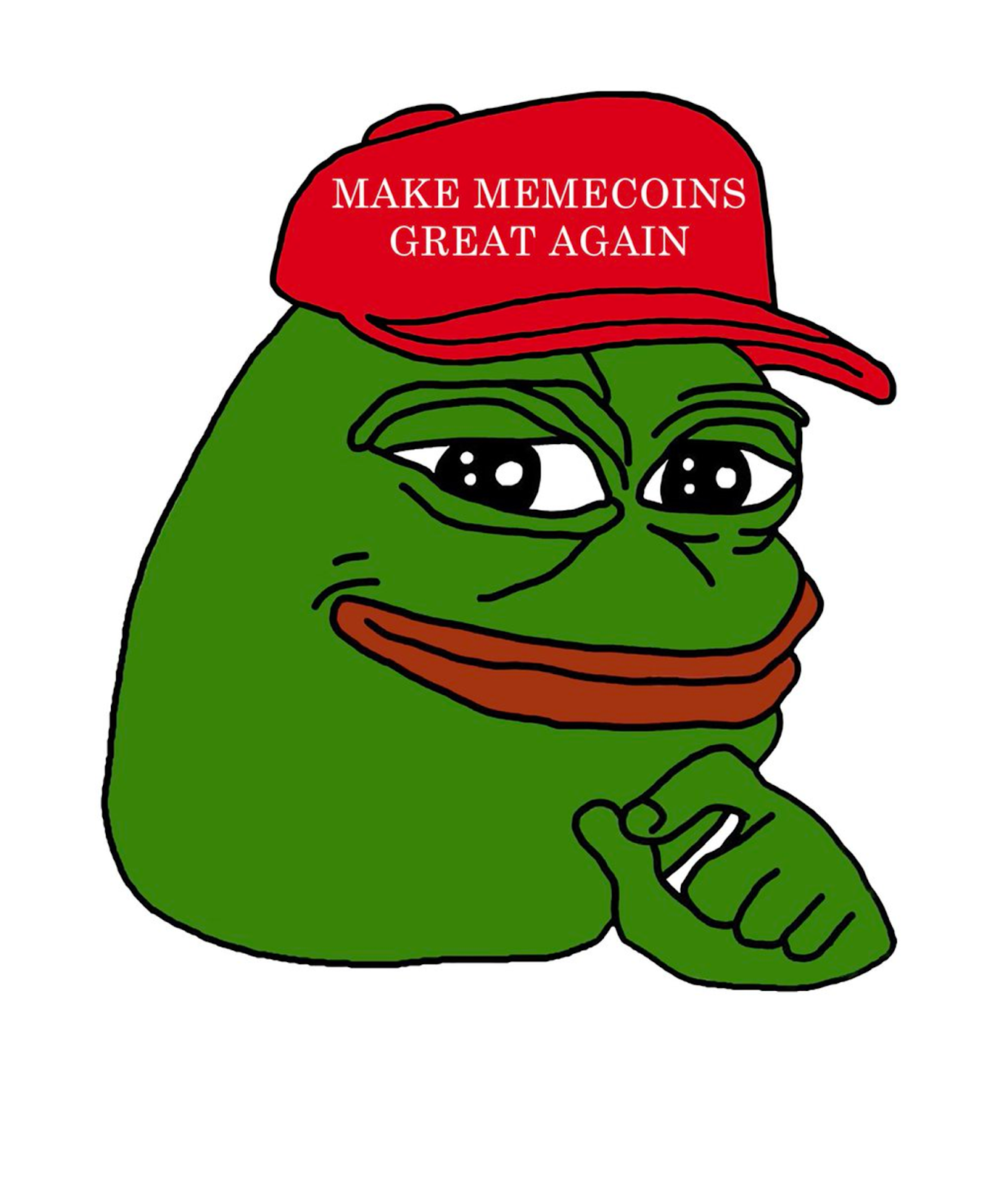
When the next tweet was posted on April 14, it directly announced the creation of PEPE Coin, a Telegram group, and an official website (the domain pepe.vip had been purchased back in March). On April 16, just two days after the token was released (allowing two days for insiders to buy), some influencers on Twitter suddenly began promoting PEPE Coin, leading to a surge in both the price and follower count of the PEPE token over the next two days. After attracting the first wave of traffic, the official PEPE Twitter account began to frequently post memes mocking other MEME Coins to maintain momentum. By April 18, Shaurya Malwa, the leader of the Coindesk Asia data team, published a short report titled "'Pepe the Frog' Meme Coins Rocket as Crypto Twitter Moves Over Dogecoin Obsession," which garnered significant exposure for PEPE. Just a day later, on April 19, several first- and second-tier exchanges began posting tweets and polls related to Frog, with many exchanges even listing PEPE directly.

Thus, PEPE's ascent began to gain unstoppable momentum. Unlike its two Shiba Inu predecessors, which took years to achieve success, the "well-planned" PEPE skyrocketed to fame in just four days and reached an astonishing increase of 375,000 times within a few months.
Silly Dragon (summarized from "Reviewing Silly Dragon's Journey to Thousands of Times")
Silly Dragon is a MEME Coin that took off alongside the revival of Solana, and it has now become a spiritual symbol within the community. The origin of this silly dragon dates back to the Solana Breakpoint conference on October 30, 2023, where Solana co-founder Anatoly appeared dressed in a green dragon costume. Anatoly first self-deprecatingly referred to himself as a silly dragon and then provided a profound explanation for his outfit: "I stand here in a dragon costume, which is crucial for our discussion about what we are building and why we are building it. We need to know what our goals are and what we want to achieve."
For Solana, which has risen from the ashes during the bear market, this silly dragon seems to carry many special "meanings." Twenty days after the conference, a Twitter account named DrakoSolana posted its first tweet, featuring a silly dragon avatar modified from a MEME image. DrakoSolana gained significant attention during this wave, but unfortunately, although it was the first silly dragon on Twitter, it was overtaken by an account named Silly Dragon due to delays in launching its token.

Silly Dragon initially had no advantages in terms of attention or timing, but they cleverly released their token SILLY first. After the token launch, the popularity of Silly Dragon began to rapidly surpass others, and with the influx of massive traffic, Silly Dragon capitalized on the momentum by hosting a silly dragon art contest.
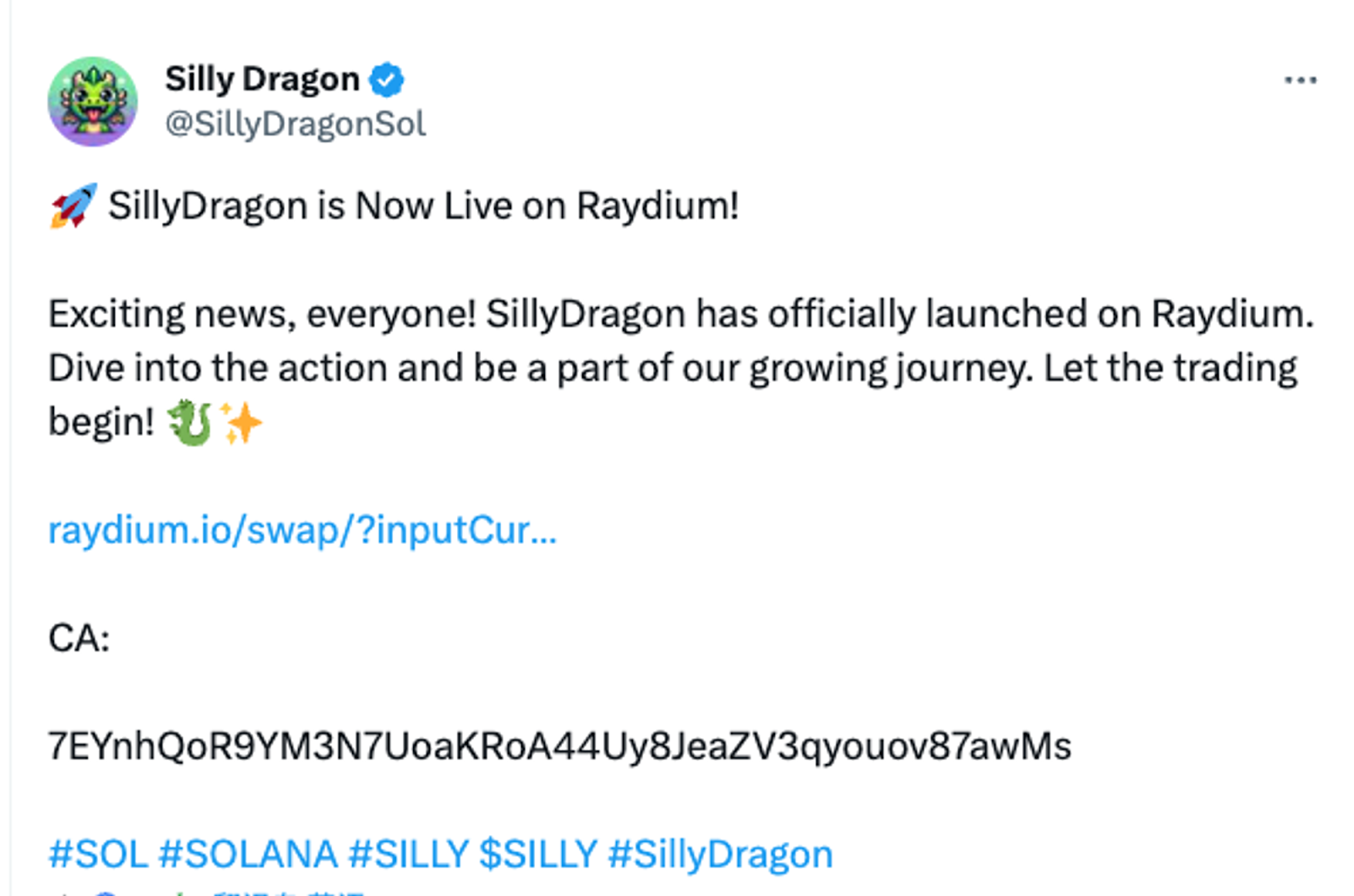
It was during this event that Silly Dragon caught Anatoly's attention. Although the token price had not yet taken off, on December 16, Anatoly tweeted: "We urgently need silly dragon MEME memes; Samsung and Apple have 1 billion device sales, while Solana phones only have 20,000." This tweet instantly ignited community enthusiasm, and the price of SILLY began to soar, creating a new myth of thousands of times.
Harry Potter Obama Sonic 10 Inu
This might be the longest and most absurdly named token you've ever seen, Harry Potter Obama Sonic 10 Inu (due to the ridiculous length of the name, it will be abbreviated as HPOS1I here, although their token name is Bitcoin). This token highlights its parody nature right in its name, and the absurdity doesn't stop there. HPOS1I went viral on the internet when it was deployed on May 10, 2023, with a hilariously crude parody website filled with videos, images, and parody stories featuring elements like Harry Potter, former U.S. President Obama, Sonic the Hedgehog (the protagonist of a well-known parkour game), cryptocurrency, and the Illuminati. It was a direct shot at various classic hot topics in Western social networks.
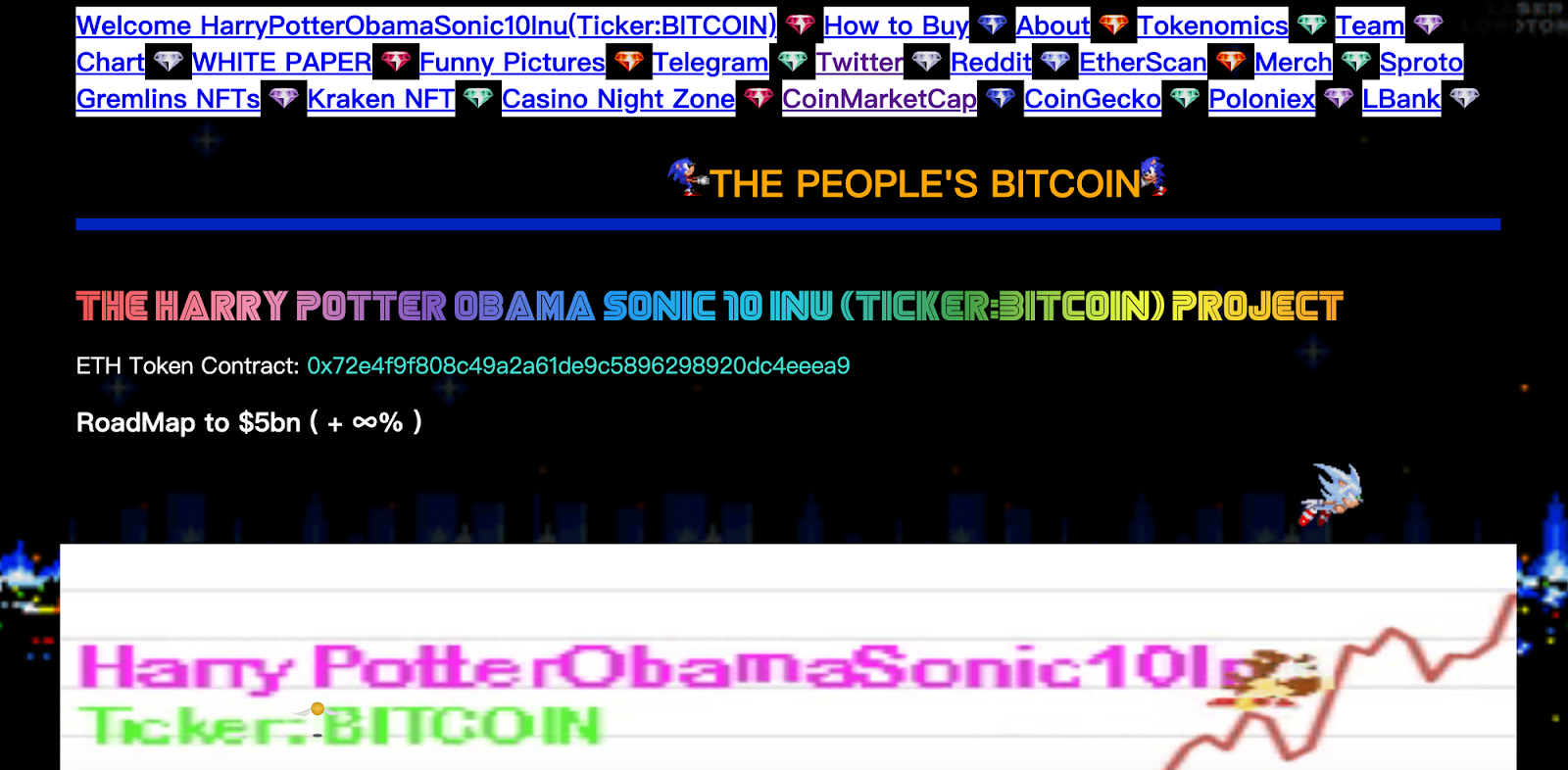
HPOS1I's development approach is also quite unique; the project's ownership has been abandoned, and there are no developers, with the community leading its growth. This is one of the project's unique selling points, representing a purely community-driven development of MEME culture. As various MEME images spread wildly across social networks, the price of HPOS1I steadily climbed, reaching a peak of $0.1783 in August 2022, achieving a miraculous hundredfold success during the bear market.
Pogai

The slogan from Pogai reads: "The most ridiculous meme in history, the most flamboyant panda person, and our most cherished youthful days." Its image is the panda person most familiar to the Chinese internet community. It is a token that has no fees, no copyrights, and no development roadmap, driven purely by the community. The community can decide the future direction, and all tokens are distributed, with the founder keeping only one hundred million Pogai tokens to work with the community as silly panda family.
The project gained attention through flamboyant and humorous promotional methods, constantly making waves in the Chinese Twitter community, combined with the familiar panda head meme, leaving a lasting impression. The project was launched on May 2, 2023, with an issuance price of $0.000008 and a peak price of $0.0005. Although it didn't experience the exaggerated increases of other MEME Coins, it still left a significant impression.
SATS
In December 2022, Bitcoin developer Casey Rodarmor released an open-source software called ORD, which runs on top of Bitcoin Core. ORD allows users to mint Bitcoin inscriptions in two steps: entering any information, such as a string of text or an image (the "inscription"), on the Bitcoin blockchain, linking the uploaded inscription to a specific Satoshi. A Satoshi is the smallest unit of Bitcoin. 1 BTC = 100,000,000 satoshis. The final product is a Satoshi with an inscription, known as a Bitcoin inscription.
Based on whether the input information is text or an image, Bitcoin inscriptions can be divided into two categories. Text-based inscriptions are primarily used to create tokens, such as the BRC-20 standard. Image-based inscriptions are mainly used to create NFTs, such as various cartoon characters.
SATS is a MEME inscription based on the BRC20 standard (I personally prefer to call inscriptions split text NFTs, but there is now a more accurate term for inscriptions, which is semi-fungible token), with its full name being Satoshi, the smallest unit of Bitcoin, commonly referred to as "聪" or Nakamoto. 1 BTC is equivalent to 100 million "聪," with a total supply of 21 trillion, equivalent to 21 million BTC.
The minting process for SATS took nearly half a year, with the inscription deployed on the blockchain in March and the entire minting completed by September. Unlike the parody and rebellious culture of traditional MEME Coins, SATS is quite special, as it signifies "聪" or Nakamoto (the basic unit of Bitcoin and its founder). The total amount corresponds to the total amount of BTC, carrying deep meanings of homage to BTC and commemoration of Nakamoto. The successful minting of such a large total amount reflects the strong consensus around this inscription. The popularity of SATS continued to grow, and on December 12, 2023, the day it was listed on Binance, its market cap doubled, soaring to $1.15 billion, even surpassing the first inscription, ORDI, ultimately achieving a peak increase of 25,000 times.
The Diversification of MEME Coins
From the MEME Coins discussed above, it is not difficult to see that MEME Coins have shifted from being dominated by dog-themed tokens to a more diversified development direction. The current categories can be divided into the following four types:
1. Classic MEMEs: Tokens representing classic MEME images such as PEPE and Pogai. Many classic MEME images that have not yet been tokenized or have failed to do so include Trollface, Grumpy Cat, Success Kid, and Kermit the Frog.
2. Crypto-native MEMEs: MEMEs derived from crypto-native "jokes," represented by BONK and Silly Dragon, both originating from the Solana community. There are also some imitative MEME Coins, such as Polygon's "Polygon Dragon."
3. Inscription MEMEs: Inscription MEMEs represented by SATS and RATS. Due to the unique issuance method of inscriptions, these MEMEs may not even have image representations but instead use text as their medium. Most have meanings of homage, commemoration, and satire, such as SATS paying tribute to BTC and Nakamoto (which can also be considered a crypto-native culture), and RATS having a satirical meaning related to insider trading and exchanges.
4. Original MEMEs: MEMEs represented by HPOS1I and Ladys, which have an original style distinct from the simple imitations of past MEME Coins.
What Elements Are Needed for the Success of MEME Coins?
Determining whether a MEME Coin can succeed is actually a very difficult task. As a product of parody culture, the source of its value is often debated. Personally, I believe the success of MEME Coins comes from cultural recognition, promotional ability, and narrative direction. Below, I will discuss my personal insights using representatives from MEME Coins.
The Carrier of MEMEs is Important
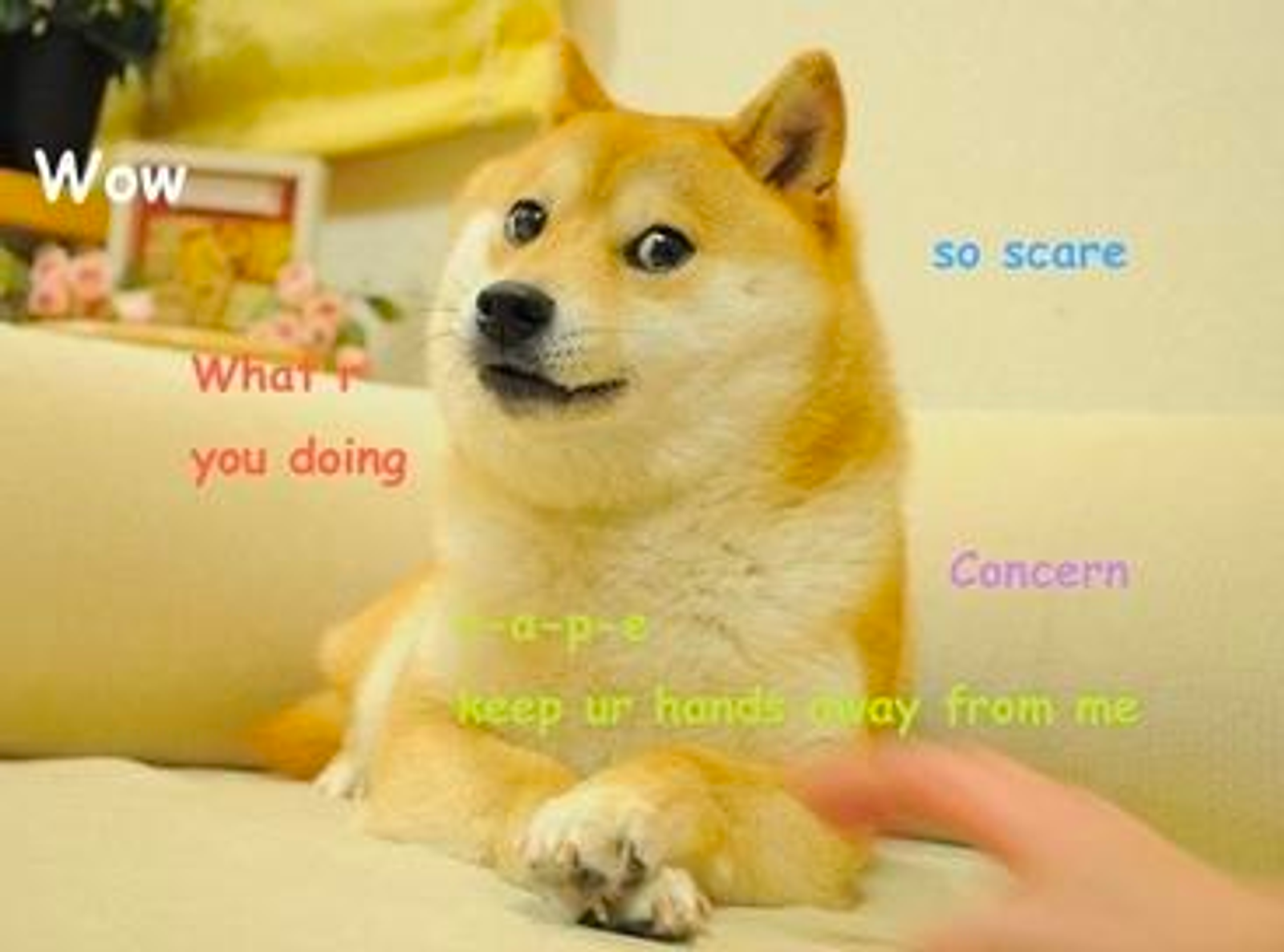
In the crypto market, we often hear various myths of wealth created by MEMEs, but in reality, only three MEME projects rank within the top 100 by market cap: Dogecoin, PEPE, and Shib. Here, we will first discuss the first two (while Shib is essentially a copy of Dogecoin and uses the classic Shiba Inu image, its success is more attributed to grassroots culture and external environmental factors, so it will not be elaborated on here). The biggest commonality between Dogecoin and PEPE is that they both utilize already classic MEME images. Hannah Arendt once said that only things that are widely discussed and have a broad public base have vigorous vitality; everything else is fleeting and unworthy of mention. This statement applies equally to MEME Coins, as the extent of the audience determines the upper limit of a MEME Coin (though it does not determine the lower limit). In the last bull market, there were many non-Shiba Inu MEME Coins that were extremely popular, such as Pig, Feg, and various animal tokens. Why did they not survive? The main reason is that the factors driving the public to buy them were the FOMO emotions and herd mentality brought about by various wealth myths. The MEME elements of these tokens mostly came from self-created images or stories by the project team. The true audience for these MEME elements is very small; token holders are merely looking to profit and may not be interested in these unfamiliar MEME elements. Once the market turns sour, these MEME Coins are not far from zero.
Both Dogecoin (the source of the "Doge" image) and PEPE are MEME images that have been popular in Western networks for over a decade (because they do not align with Chinese MEME culture, we often only notice these tokens when they are surging, although the emergence of Pogai in 2023 also indirectly confirms the importance of the MEME audience). Various parody memes about them have already penetrated deeply into people's hearts, with a very broad audience (and they can easily catch the attention of influential figures), thus their viral spread is incredibly strong.
Why Did PEPE Succeed?
As mentioned earlier, the PEPE we are familiar with today is not the first PEPE Coin. So why did the early PEPE (there is an even earlier PEPE inscription on BRC20) fail? The fundamental reason lies in the lack of promotional ability. Excellent promotional ability not only accelerates the success of a MEME Coin but also determines its lower limit.
For example, in our daily lives, the more well-known a brand is, the more it invests in advertising. For any product, its advertising audience can be divided into high-frequency consumers, low-frequency consumers, and non-consumers. The mechanisms by which advertising works on these three types of people are different, and the logic of effective advertising stems from four aspects—informing, persuading, reminding, and reinforcing. The promotional logic of MEME Coins should also follow this, solidifying community members and speculative buyers while bringing in more potential buyers. Therefore, in addition to selecting the right carrier, the method of "spreading the word" is equally important.
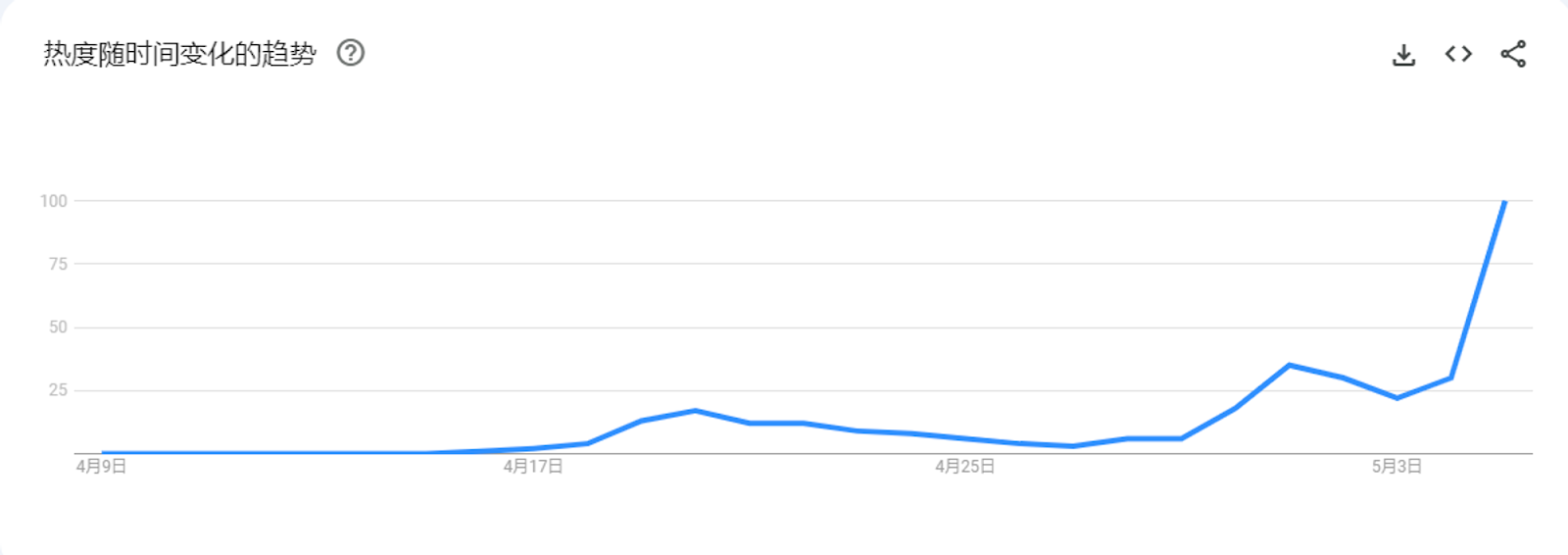
PEPE's rapid success can be attributed to its adept use of human nature in its promotional methods. Looking back at the PEPE section above, it is not difficult to see that these influencers had already quietly purchased PEPE tokens, and the bundling of interests drove them to promote vigorously. Additionally, the pre-planned domain name and the token's roadmap (with relevant personnel in the team coordinating with exchanges) caused the price and the number of holders to rise sharply in a short period. Coupled with PEPE's existing viral memes and these favorable news, the explosive viral spread began. The intensity of a fire depends on the amount of fuel; PEPE's fire certainly burned with a sweeping momentum. Thus, PEPE's emergence was not merely a stroke of luck; how the project team coordinated planning to create an extreme herd effect without fizzling out is not simple at all. (Readers interested in this can compare the early related tweets of the $pepe.BRC-20 and PEPE accounts.)
A MEME That Doesn't Want to Be a MEME—Shib
Rewinding a few years, I remember asserting that Shib would surely fail. In the Web3 space, a copycat trying to challenge an OG is almost a pipe dream. However, Shib later slapped me with a hard reality check. Looking back at Shib's comeback, I still believe it was a miracle brought about by multiple factors. If we analyze Shib while setting aside some luck factors (such as economic stimulus and relevant tweets from Musk), I personally believe Shib's uniqueness lies in its excellent community culture and bold narrative direction.
All dog-themed MEME Coins face a fatal problem: since these tokens are simple derivatives of Dogecoin, they suffer from severe homogeneity, and the MEME images created by the project team and community have very weak viral potential on social networks. As mentioned earlier, their true audience is very small. Shib also faced this issue; in terms of recognition in Western internet culture and celebrity influence, Dogecoin had an absolute advantage, and a derivative cartoon image of a Shiba Inu could never become the "Dogecoin killer."
Thus, Shib's narrative direction could only be ecological—a MEME Coin with expectations of a Swap, cross-chain bridge, Layer 2, and metaverse. Doesn't that elevate its status? Although Shib's development direction faced many doubts, I personally believe this is the correct and only way to sustain its vitality as a Dogecoin killer.
Conclusion
The MEME Coin market is always full of temptation but also comes with high risks. According to CoinMarketCap data, there are 1,467 tokens in the MEME space, and if we only count the top 300 by market cap, there are only 9, resulting in a success rate of less than 1%. Currently, with the evolution of MEME Coins and the addition of inscription-type MEMEs, the complexity of selection is increasing. If you genuinely want to purchase some MEME Coins today, you need to do your homework on some special cultures related to crypto and Western MEME culture. A potentially successful MEME project should at least possess cultural recognition, promotional capability, narrative direction, and community involvement.










